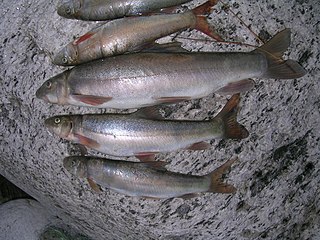
Acrossocheilus is a genus of ray-finned fishes in the family Cyprinidae, native to freshwater in China, Taiwan, Laos, and Vietnam. They are fairly small, no more than 30 cm (1 ft) in standard length.

Schizothorax is a genus of cyprinid fish found in southern and western China, through northern South Asia (Himalaya) and Central Asia, to Iran, with a single species, S. prophylax, in Turkey. They are primarily found in highland rivers, streams and lakes, although a few species occur in lower-lying locations, like Lake Balkhash and lakes of the Sistan Basin. Their scientific name means "cloven-breast", from Ancient Greek schízeïn (σχίζειν) 'to cleave' and thórax (θώραξ) 'breast-plate'. The western species are typically referred to as marinkas from their Russian name marinka (маринка), while the eastern species are usually called snowtrout. Although they do resemble trouts in habitus this is merely due to convergent evolution and they are by no means closely related apart from both being Teleostei: Cyprinids are in the teleost superorder Ostariophysi, while trouts are in the superorder Protacanthopterygii. Their ancestors must thus have diverged as early as the Triassic, more than 200 million years ago.

Onychostoma is a genus of cyprinid fish found in eastern Asia.

Siniperca or the Chinese perch is a genus of centrarchiform ray-finned fish native to freshwater habitats in continental East Asia. Although its native ranges can extend to northern Vietnam, the majority of the species are entirely or largely restricted to China.

Psilorhynchus is a genus of ray-finned fish in the family Psilorhynchidae native to South Asia. This genus is the only member of its family. The members of Psilorhynchus are small benthic fishes which occur in rivers and streams with fast to swift currents, hence they are often referred to as torrent minnows. They are distributed in southern Asia, in the Indo-Burma region and the Western Ghats.
Poropuntius kontumensis is a species of ray-finned fish in the genus Poropuntius. This species is native to Cambodia and Viet Nam. Its species named after Kontum.

Hypsibarbus is a genus of cyprinid fish that is found in freshwater in Mainland Southeast Asia, including the Thai-Malay Peninsula.

Schizopygopsis is a genus of cyprinid fish. Most species are endemic to river basins in the Himalayas and Qinghai–Tibet Plateau of China, but S. stoliczkai extends into the highlands of Afghanistan, Iran, northern India, Kyrgyzstan, Pakistan and Tajikistan.

Henicorhynchus is a genus of cyprinid fish that occurs in Southeast Asia.

Osteochilus is a genus of freshwater ray-finned fish belonging to the family Cyprinidae, the family which includes the carps, barbs, minnows and related fishes. The fishes in this genus are mainly found in Southeast Asia with a few extending into adjacent parts of China.

Procypris is a genus of freshwater ray-finned fish belonging to the family Cyprinidae, the family which includes the carps, barbs, minnows and related fishes. The fishes in this genus are found in eastern Asia.
Semilabeo is a genus of freshwater ray-finned fish belonging to the family Cyprinidae, the family which includes the carps, barbs. minnows and related fishes. The fishes in this genus are found in southern China and Viet Nam.
Sinocrossocheilus is a genus of cyprinid fish endemic to fast-flowing rivers in China and sometimes found in caves.

Homalopteroides is a genus of freshwater ray-finned fishes belonging to the family Balitoridae, the loaches in this family are commonly known as hillstream loaches although this name also refers to the loaches in the family Gastromyzontidae. These loaches are found in Southeast Asia.
Traccatichthys is a genus of stone loaches from southern China and Vietnam.

Cyprinae is a subfamily of largely freshwater ray-finned fishes, one of ten subfamilies belonging to the family Cyprinidae. This family comprises the carps, minnows, barbs and related fishes.

Troglonectes is a genus of troglobitic fish in the family Nemacheilidae, native to caves of Asia. Fishbase and other authorities place these species in the genus Oreonectes.
Altigena is a genus of cyprinid freshwater fish found in the continental part of South East Asia. This genus was resurrected from Bangana by Maurice Kottelat in 2017.
Decorus is a genus of cyprinid freshwater fish found in China and India. This genus was split from Bangana in 2019.
Poropuntius anlaoensis, the Anlao brook barb, is a species of freshwater ray-finned fish belonging to the family Cyprinidae, the family which includes the carp, barbs, minnows and related fishes. This species was first formally described in 2024 from the southern Annam ecoregion of Viet Nam and it may be endemic to the coastal slopes of the Annamite Cordillera.












